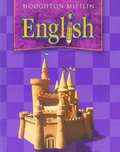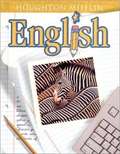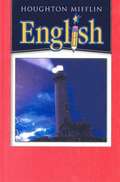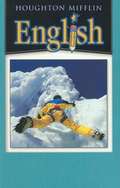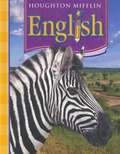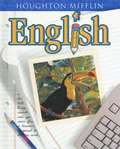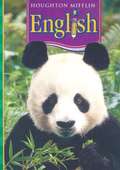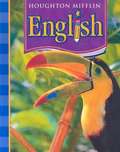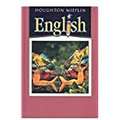- Table View
- List View
Houghton Mifflin English (Grade 7, Texas edition)
by Shane Templeton Robert Rueda Tina Saldivar Lynne Shapiro C. Ann Terry Catherine Valentino Shelby A. WolfThe writing process can help you move step by step from a blank sheet of paper to an interesting piece of writing. The writing process gives you many chances to improve your writing.
Houghton Mifflin English (Grade #3)
by Shane Templeton Robert Rueda Tina Saldivar Lynne Shapiro C. Ann Terry Catherine Valentino Shelby A. WolfThis book was authored to improve students' writing and reading skills.
Houghton Mifflin English (Grade #5)
by Shane Templeton Robert Rueda Tina Saldivar Lynne Shapiro C. Ann Terry Catherine Valentino Shelby A. WolfHoughton Mifflin English Grade 5 is a valuable guide to students to learn English Grammar and composition. The theme and style of teaching will enable students to quickly grasp and enrich their knowledge leading them to read and write on their own a good and perfect English.
Houghton Mifflin English (Grade #5)
by Shane Templeton Robert Rueda Tina Saldivar Lynne ShapiroHoughton Mifflin English covers all the fundamentals and basics of English.
Houghton Mifflin English (Grade #6)
by Shane Templeton Robert Rueda C. Ann Terry Catherine ValentinoThis book is designed to improve student's language skills under the following broad topics: grammar, usage, mechanics, writing, listening, speaking and viewings.
Houghton Mifflin English (Grade #7)
by Shane Templeton Robert Rueda Tina Saldivar Lynne Shapiro C. Ann Terry Catherine Valentino Shelby A. WolfEnglish textbook for 7th graders.
Houghton Mifflin English (Grade #8)
by Shane Templeton Robert Rueda Tina Saldivar Lynne Shapiro Houghton Mifflin Company StaffReteaching instruction and easier practice activities for skill reinforcement. Covers all the same skills as Workbook plus.
Houghton Mifflin English (Grade 2, Texas edition)
by Shane Templeton Robert Rueda Lynne Shapiro C. Ann Terry Catherine Valentino Shelby A. Wolf Tina SaldiverEach one of you is special. You share " pieces of yourself" with others when you speak. You learn from others whey you listen or view.
Houghton Mifflin English (Grade 3, Texas edition)
by Shane Templeton Robert Rueda Tina Saldivar Lynne Shapiro C. Ann Terry Catherine Valentino Shelby A. WolfGood writers use complete sentences to make their meaning clear. Sometimes you can fix a sentence that is not complete by adding it to a complete one.
Houghton Mifflin English (Grade 4, Texas edition)
by Shane Templeton Robert Rueda Lynne Shapiro C. Ann Terry Catherine Valentino Shelby A. Wolf Tina SaldiverEach one of you has your own skills, experiences, interests, and opinions. As a boy or a girl, you're like a book full of great information and ideas to share. Together as a class, you're a whole encyclopedia!
Houghton Mifflin English (Grade 5, Texas edition)
by Shane Templeton Robert Rueda Tina Saldivar Lynne Shapiro C. Ann Terry Catherine Valentino Shelby A. WolfThe writing process helps you move step by step from a blank piece of paper to an interesting piece of writing. The writing process gives you many chances to make your writing better.
Houghton Mifflin English (Grade 8, Texas edition)
by Shane Templeton Robert Rueda Lynne Shapiro Tina SaldiverEach of you is unique. You have your own special experiences, talents, knowledge, opinions, and observations. That makes you valuable resources for each other. As individuals you're like one-of-a-kind books full of information and ideas to share. Together as a class, you're a whole encyclopedia!
Houghton Mifflin English (Gradel #5)
by Shane Templeton Robert Rueda Tina Saldivar Lynne Shapiro C. Ann Terry Catherine Valentino Shelby A. WolfThis is an easy-to-use English textbook for 5th graders.
Houghton Mifflin English (Level #4)
by Shirley Haley-James John Warren StewigThis textbook will help students improve their reading, writing and speaking skills with resources of literature.
Houghton Mifflin English 4
by Shane Templeton Robert Rueda Tina Saldivar Lynne ShapiroImprove your listening, speaking, viewing and writing skills by reading this book.
Houghton Mifflin English Workbook Plus: Grade 8 (Houghton Mifflin English)
by Houghton Mifflin Company StaffHoughton Mifflin English: Level 8
Houghton Mifflin English [Grade 11]
by Shane Templeton Robert Rueda Tina Saldivar Lynne Shapiro C. Ann Terry Catherine Valentino Shelby A. WolfNIMAC-sourced textbook
Houghton Mifflin English [Grade 1]
by Shane Templeton Robert Rueda Tina Saldivar Lynne Shapiro C. Ann Terry Catherine Valentino Shelby A. WolfNIMAC-sourced textbook
Houghton Mifflin English [Grade 2]
by Shane Templeton Robert Rueda Tina Saldivar Lynne Shapiro C. Ann Terry Catherine Valentino Shelby A. WolfNIMAC-sourced textbook
Houghton Mifflin English [Grade 3]
by Shane Templeton Robert Rueda Tina Saldivar Lynne Shapiro C. Ann Terry Catherine Valentino Shelby A. WolfNIMAC-sourced textbook
Houghton Mifflin English [Grade 3]
by Shane Templeton Robert Rueda Tina Saldivar Lynne Shapiro C. Ann Terry Catherine Valentino Shelby A. WolfNIMAC-sourced textbook
Houghton Mifflin English [Grade 4]
by Shane Templeton Robert Rueda Tina Saldivar Lynne Shapiro C. Ann Terry Catherine Valentino Shelby A. WolfNIMAC-sourced textbook
Houghton Mifflin English [Grade 7]
by Shane Templeton Robert Rueda Tina Saldivar Lynne Shapiro C. Ann Terry Catherine Valentino Shelby A. WolfNIMAC-sourced textbook
Houghton Mifflin English [Grade 8]
by Shane Templeton Robert Rueda Tina Saldivar Lynne Shapiro C. Ann Terry Catherine Valentino Shelby A. WolfNIMAC-sourced textbook

